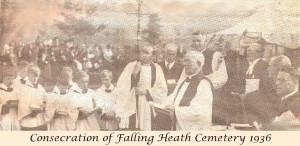 Up until 1923 the Wood Green Cemetery received about 450 bodies a year, but on June 26th 1923 the council purchased land on the Fallings Heath area to create another cemetery.
Up until 1923 the Wood Green Cemetery received about 450 bodies a year, but on June 26th 1923 the council purchased land on the Fallings Heath area to create another cemetery.
The land was littered with pit mounds, derelict buildings and was badly water logged due to mining in the area.
Financial assistance came from the Unemployment Grant Commission and the 7 acres of land was bought for £1,317. The total cost of the scheme, including the £3,500 chapel was £20,000.
The development of the cemetery was considered to be a significant stage in the overall development of the Borough of Wednesbury and the work which transformed the land was carried out under deplorable conditions. The unemployed were set to work levelling the ground during one of the worst winters on record. A total of 72,000 loads of pit mound soil was removed and was used to raise the height of the low areas by 12 feet.
1.1/4 miles of drainage was laid, along with 2 miles of roads, drives and paths put down along with ¾ mile of borders. The land was so water logged that paths and timbers were known to sink and disappear. This showed the necessity of placing sub-soil on the top to provide drainage.
The cemetery was formerly opened and consecrated on September 22nd 1936 by the Bishop of Stafford, the Rvd D. H. Crick, who was formerly the Vicar of Wednesbury. The gates were opened using a key specially presented to the Bishop.
The Mayor, Alderman B. W. Griffiths, gave a speech explaining how the land was transformed to accommodate 14,750 graves.


You must be logged in to post a comment.